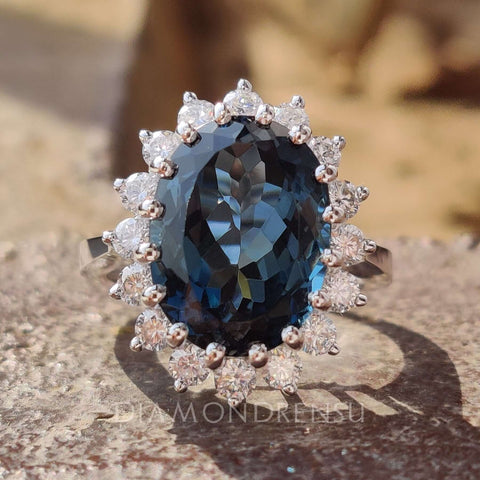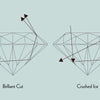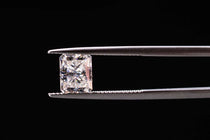When it comes to selecting a diamond, one of the key factors that every diamond enthusiast considers is the proportions of the stone. Ideal diamond proportions play a crucial role in determining the overall beauty, brilliance, and fire of the gem. By understanding these proportions, we can make informed choices when purchasing diamonds, ensuring that we choose stones that exhibit the best balance of aesthetics and value.
Round brilliant cut diamonds, for example, have a specific set of proportions known for maximizing their brilliance and fire. The careful balance of table size, crown angle, pavilion angle, and other factors contribute to the polished gem's ability to reflect and refract light optimally. Researchers have conducted extensive studies to identify these optimal proportions, such as the one found in GIA's research.
Throughout this article, we will delve deeper into the concept of ideal diamond proportions and explore how they impact the appearance of our beloved gems. By the end of this discussion, we will have a better understanding of what to look for in a diamond and why proportions matter so much.
Understanding Diamond Proportions
When assessing the quality of a diamond, it's essential to consider proportions. Proportions refer to the relationship between various geometric aspects of the diamond, which have a significant impact on the overall appearance and quality.
One vital factor when evaluating diamond proportions is the depth. Depth refers to the diamond's height from the culet to the table and contributes significantly to the stone's brilliance. Depth percentage, calculated as the ratio of the diamond's depth to its overall width, is crucial in determining the sparkle and brightness of the diamond. A well-proportioned diamond will have an optimal depth percentage to maximize the stone's reflective properties.
The table is another essential factor in understanding diamond proportions. The table, meaning the top facet of the diamond, plays a significant role in the stone's light reflection. Table percentage is the ratio of the table's width to the diamond's overall width, influencing the diamond's fire and sparkle. An ideal table size allows for optimal light reflection without compromising the stone's durability.
The culet, or the small facet at the bottom of the diamond, is another consideration in evaluating proportions. An ideal culet should be small or even nonexistent, as a larger culet can create an undesirable inclusion-like appearance, reducing the diamond's brilliance.
Girdle thickness, the parameter that refers to the outer edge of the diamond, holds importance as well. A well-proportioned diamond will not have a girdle that is too thin or thick, ensuring structural integrity and optimal visual appeal.
Crown and pavilion angles are also crucial in determining diamond proportions. The crown angle, which governs the top portion of the diamond, relates to the stone's overall brilliance. The pavilion angle, responsible for the lower part of the diamond, directly impacts the light reflection within the diamond. Ideal crown and pavilion angles work in tandem to ensure maximum brilliance and sparkle.
Length-to-width ratio is another proportion to consider, particularly for fancy-shaped diamonds such as emerald-cut, oval, or pear. This ratio compares the diamond's length to its width, influencing the stone's overall appearance and how it sits in the setting. An optimal length-to-width ratio ensures a visually appealing and well-balanced diamond.
In conclusion, understanding diamond proportions is paramount in evaluating the quality and appearance of a diamond. By paying attention to factors such as depth, table, culet, girdle, crown and pavilion angles, and length-to-width ratios, we can make a more informed decision when selecting the perfect diamond.
Cut Grades and Rating Systems
| Rating System | Cut Grade | Description |
|---|---|---|
| GIA | Excellent | Reflects nearly all light, creates maximum fire and brilliance |
| GIA | Very Good | Reflects most light, with good fire and brilliance |
| GIA | Good | Reflects a majority of light, with some fire and brilliance |
| GIA | Fair | Reflects some light, with minimal fire and brilliance |
| GIA | Poor | Reflects only a small amount of light, lacks fire and brilliance |
| AGS | 0 Ideal | Superior light performance; the highest rating for cut quality |
| AGS | 1 Excellent | Exceptional light performance; very slight differences from ideal |
| AGS | 2 Very Good | Very good light performance; slightly outside the ideal range |
| AGS | 3 Good | Good light performance; noticeable deviations from ideal |
| AGS | 4 Fair | Fair light performance; significant deviations from ideal |
When it comes to diamonds, the quality of the cut plays a significant role in determining the stone's overall beauty and value. Cut grades and related rating systems help us evaluate the quality of a diamond's cut. In this section, we will discuss the various cut grades and rating systems used by organizations like GIA (Gemological Institute of America) and AGS (American Gem Society).
- The cut grade of a diamond is determined by factors such as its proportions, symmetry, and polish. These aspects contribute to the overall cut quality, which is commonly rated on a scale of Excellent, Very Good, Good, Fair, and Poor.
- GIA and AGS are two of the most reputable organizations in the diamond industry. They have established specific parameters for evaluating diamond cut quality. GIA's cut grading ranges from Excellent to Poor, while AGS uses a numeric scale from 0 (Ideal) to 10 (Poor).
- An Excellent cut grade indicates that a diamond has ideal proportions, exceptional symmetry, and outstanding polish, making it a highly desirable stone. This category includes the Tolkowsky Ideal Cut, which boasts impeccably balanced proportions for maximum brilliance and fire.
- Very Good cut diamonds have subtly different proportions compared to those with an Excellent grade. These diamonds still exhibit remarkable beauty and value, although with slightly fewer degrees of brilliance and fire.
- A Good cut grade diamond has proportions that deviate from the ideal parameters, leading to a reduced level of sparkle and fire. However, such diamonds can represent a more affordable option for buyers while still maintaining a level of beauty worthy of admiration.
- Fair cut diamonds exhibit noticeable deviations from ideal proportions, resulting in a significantly lower level of brilliance and fire. These diamonds may appeal to budget-conscious buyers who prioritize carat weight over optimal beauty.
- Lastly, a Poor cut grade diamond has severe inconsistencies in proportions, symmetry, and polish. These stones possess minimal brilliance and fire, making them the least desirable option in terms of cut quality.
In conclusion, understanding cut grades and rating systems is essential when evaluating the quality of a diamond. By considering these factors, we can ensure that we select a beautiful diamond that meets our standards and preferences.
Effect on Light Performance

When discussing diamond proportions, it is essential to consider their effect on light performance. Light performance refers to how a diamond reflects, refracts, and returns light to the viewer. The elements that contribute to light performance include sparkle, fire, scintillation, appearance, and brilliance.
In our experience, ideal proportions play a pivotal role in maximizing a diamond's light performance. A well-cut diamond will effectively balance each aspect, ensuring that it reflects light in a manner that enhances its overall appearance.
Sparkle refers to the white light that is reflected back to the observer when light enters a diamond. Achieving a high level of sparkle requires a combination of proper angles, facet sizes, and overall proportions. The Gemological Institute of America (GIA) has conducted extensive research, demonstrating that cut proportions significantly affect a diamond's sparkle.
Fire is the term used to describe the dispersed light or spectral colors seen within a diamond. The research on the round brilliant diamonds highlights the effects of various proportions on fire. A well-proportioned diamond will effectively disperse light and display a balanced level of fire.
Scintillation refers to the patterns of light reflections that dance within a diamond as it moves. The degree of scintillation can be influenced by the interaction between the facets and the light. According to a comparison of light distribution in different diamond models, ideal proportions and facet placement can enhance the scintillation effect.
Brilliance, on the other hand, refers to the combination of internal and external reflections of white light in a diamond. Proportions play a significant role here as well. The GIA's research has emphasized that cut proportions and a diamond's performance are closely linked.
In conclusion, the light performance in a diamond is greatly influenced by its proportions. By understanding the intricate relationships between proportions, sparkle, fire, scintillation, and brilliance, we can better appreciate the artistry and skill involved in crafting a well-proportioned and stunning diamond.
Significance of Diamond Design
When it comes to diamond design, it is essential to understand the importance of the right proportions, angles, and mathematical calculations to ensure the highest level of brilliance and fire in a diamond. In the early 20th century, Marcel Tolkowsky, a Belgian engineer and mathematician, made significant contributions to the field of diamond design by establishing the Ideal Cut.
Tolkowsky's mathematical calculations provided us with the basis for what is known as the "Ideal Cut" for round brilliant diamonds. This cut is designed to achieve maximum light reflection and refraction, resulting in a stunning balance of brilliance, fire, and scintillation. By carefully determining the proportions and angles, we can optimize a diamond's ability to reflect and refract light, enhancing its overall beauty and value.
The crucial aspect of diamond design lies in the precision of achieving the Ideal Cut dimensions. Many factors contribute to a diamond's visual appeal, including the table size, crown angle, pavilion angle, and depth. The specifications set forth by Tolkowsky have become industry standards that help us guide the cutting and polishing process.
We always strive to create diamonds that reflect the precision and care involved in the cutting process. This meticulous attention to detail enhances the overall beauty and desirability of these precious stones. However, it is important to remember that while the Tolkowsky Ideal Cut provides a blueprint for maximizing a diamond's potential, different diamond shapes and personal preferences might lead to slight variations in design.
In summary, the significance of diamond design lies in the delicate balance of proportions, angles, and mathematical calculations. Following the guidelines set forth by Tolkowsky, we can achieve the most spectacular results in terms of brilliance and fire, ensuring that our diamonds are not only visually appealing but also valuable investments.
Diamond Shapes and Their Proportions

When it comes to diamond shapes, each has specific proportions that contribute to their unique beauty and sparkle. In this section, we'll explore some of the most popular diamond shapes and the ideal proportions for each.
- Round Brilliant Diamonds: The round brilliant cut diamond is the most popular and timeless diamond shape. It boasts 58 facets, which maximize its light return and sparkle. The ideal proportions for a round brilliant diamond include a table percentage of 53-58%, a depth percentage of 59-63%, and a pavilion angle of 40.6-41 degrees. These proportions ensure the most attractive balance of brilliance, fire, and scintillation in a round cut diamond.
- Pear-shaped Diamonds: The pear shape is a hybrid of the round brilliant and marquise shapes, characterized by its teardrop shape. Ideal proportions for a pear-shaped diamond include a length-to-width ratio of 1.45-1.75. This ratio ensures a visually appealing, well-balanced stone with optimal sparkle.
- Marquise Diamonds: The marquise shape is an elongated shape with pointed ends, which gives the appearance of a larger diamond. Ideal proportions for a marquise diamond include a length-to-width ratio between 1.85-2.10, which creates a visually appealing, slender shape without sacrificing brilliance.
- Oval Diamonds: The oval shape is a popular choice for those seeking a unique and elegant diamond. Ideal proportions for an oval diamond include a length-to-width ratio between 1.35-1.50. Maintaining this ratio ensures that the diamond retains its brilliance and a symmetrical, balanced shape.
- Emerald Diamonds: The emerald cut is known for its step-cut faceting, which gives it a vintage and elegant appearance. Ideal proportions for an emerald diamond include a depth percentage of 60-70% and a length-to-width ratio between 1.30-1.40 for square shapes or 1.45-1.55 for rectangular shapes. These proportions contribute to the stone's large, open table and maximize the diamond color and clarity.
- Princess Diamonds: The princess cut is a popular square shape that offers exceptional brilliance. Ideal proportions for a princess diamond include a table percentage of 62-68%, a depth percentage of 68-75%, and a length-to-width ratio of 1-1.05. These proportions maximize light performance and create a visually appealing stone.
- Asscher Diamonds: The Asscher shape is similar to the emerald cut, but it features a square shape with larger step facets. Ideal proportions for an Asscher diamond include a depth percentage of 60-70% and a length-to-width ratio between 1-1.05 for a balanced, symmetric appearance and optimal light performance.
In conclusion, understanding the ideal proportions for each diamond shape helps to ensure the highest quality and most visually stunning result. Each shape has its own unique characteristics and ideal proportions, which contribute to the diamond's overall beauty and value.
Assessing Diamond Quality
When it comes to determining the value of a diamond, there are several factors that play an essential role. In our experience, the most crucial factors are carat weight, clarity, and the quality of the diamond's cut. The diamond industry relies on grading laboratories to establish standardized assessments for these attributes. Two well-known examples are James Allen and White Flash.
Carat weight is the simplest to understand as it measures the size of the diamond. The price of a diamond usually increases with the carat weight. However, it's important to remember that weight is not the only determinant in the diamond's value. Other factors such as clarity and cut can significantly impact the overall worth of the stone.
Clarity refers to the presence or absence of imperfections or inclusions within the diamond. Grading laboratories use a standardized scale to rate the clarity, which ranges from flawless to included. Diamonds with higher clarity grades are generally more valuable, as they are rarer and in higher demand.
The cut of a diamond is arguably one of the most significant factors in determining its beauty and brilliance. An ideal cut diamond has specific proportions that maximize the light entering the stone, creating an optimal level of brightness, fire, and scintillation. The Gemological Institute of America (GIA) has created a standardized scale to assess the cut quality of round brilliant cut diamonds. This scale ranges from excellent to poor and is based on the proportions and angles of the diamond's facets.
We recommend choosing ideal cut diamonds whenever possible, as they are crafted with precision and care. Keep in mind that the quality of a diamond's cut can have a significant impact on its price and overall attractiveness. By considering all these factors, we believe that you'll be better equipped to make informed decisions when selecting the perfect diamond.
Frequently Asked Questions
What are the best measurements for a round diamond?
The best measurements for a round diamond depend on the diamond's cut grade, which primarily focuses on the proportions and symmetry. A well-proportioned diamond will have an ideal balance between diameter, crown height, pavilion depth, and other aspects. The most sought-after round diamond cut is the ideal-cut round diamond, which exhibits maximum brilliance and fire.
What factors determine the ideal cut of a diamond?
Several factors play a role in determining the ideal cut of a diamond, including its proportions, angles, symmetry, and polish. Proper proportions allow light to enter the diamond and reflect back through the top, enhancing its brilliance and fire. Angles, particularly the crown and pavilion angles, contribute to a diamond's proper light reflection. Additionally, good symmetry and polished facets ensure a diamond's precision, which enhances its overall appearance.
How do diamond proportions affect a diamond's appearance?
Proper diamond proportions significantly impact the stone's appearance by influencing its brilliance, fire, and scintillation. When a diamond has ideal proportions, light can enter the stone and be optimally reflected back to the viewer's eye, resulting in a visually attractive gem. On the other hand, a poorly proportioned diamond will lose light through the pavilion, making it appear dull and lifeless.
Do different diamond shapes have specific ideal proportions?
Yes, different diamond shapes have specific ideal proportions that influence their overall appearance and value. Round diamonds, for example, have specific ideal cut proportions, while princess, oval, cushion, and other fancy shapes have their own set of recommended proportions. These unique proportions help maximize light performance and enhance the aesthetic appeal of each diamond shape.
What tools are used to evaluate diamond proportions?
Professional gemologists and jewelers use several tools to evaluate diamond proportions accurately. One common tool is the diamond proportion analyzer, which measures the crown angle, pavilion angle, table size, and other important aspects of a diamond's cut. This information enables them to compare a diamond's actual proportions to its ideal proportions, ensuring customers receive a well-cut stone.
How do AGS and PriceScope criteria differ for ideal proportions?
The American Gem Society (AGS) and PriceScope are two prominent organizations within the diamond industry, and both have their own criteria for determining ideal proportions. AGS follows a series of strict standards for proportions, symmetry, and polish, while PriceScope uses the Holloway Cut Adviser (HCA) tool to analyze individual diamonds for light performance. The HCA evaluates a diamond's light return, fire, scintillation, and spread to derive a score, which helps users make informed decisions about a diamond's cut quality.
Checkout some of our top collections:











